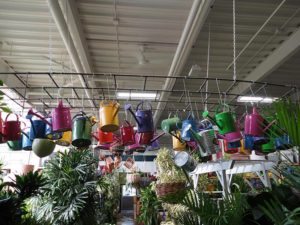
Keeping it Focused!
Managing a garden center today is challenging in a dynamic, complex, market-driven, highly competitive environment that changes at warp speed dictated not only by external factors, but by weather. While you can anticipate and plan for some of these, others you have no control over and just have to adapt to.
Add to this the reality of dealing with the demands and expectations of your shareholders — those who expect a return on their investment, as well as your stakeholders — your employees, lenders, trade partners, and customers, all of whom are different. This creates another layer of management considerations.
Monitoring the Numbers
Thankfully, with the aid of computer programs, you can input, manage and review your costs, expenses and inventories by category against plans, as well as capturing Point of Sale data to track sales and help maintain a perpetual inventory to factor buy plans. With this information, you’re able to generate the financial information demanded by your lenders in order to get operating loans and funds for capital improvements, the cash flow projections required by your trade partners to obtain the most advantageous terms, and stay in stock for your customers while minimizing retail shrink due to overstocks — and better manage your entire retail operation.
Most likely, you spend time reviewing the key ratios such as payroll, expenses like utilities and rent, marketing, and inventory turnover and shrink. And seasonally, among other information, your lenders ask you for your historical returns on invested capital, cash flow and other ratios to ensure you are financially stable before they extend loans.
Reviewing and comparing expense ratios to plan is a quick and easy way to get a snapshot of performance, highlighting those areas of opportunity while there’s still time to make the necessary corrections. When operating and variable expense ratios are higher than planned, the quick fix is often to cut the finite expense investments, cutting payroll and marketing dollars, as an example, to get the ratios back in line. In the heat of battle, we sometimes forget that most of these ratios are measured as percentages to sales.
There’s an old retail adage: “sales cure all evils” — and this still rings true today! If sales increase above plan, then ALL operating costs and expense ratios improve. Likewise, if sales are below plan, then all expense ratios are under water and all must be cut in order to maintain ratios to plan.
In my long experience, I’ve learned (the hard way, in many cases!) that focusing on the key elements that have the most impact on financials pays the biggest dividends, and these are sales and initial markup or margin (the sales less acquisition costs that generate your initial pool of profit dollars).
Before I go any further, allow me to make one key observation. You are a destination shop; customers have already made a conscious decision to make a unique shopping trip to your store and, as a result, have a very high propensity to purchase. Chances are they did not come to you because you have the lowest prices in the market, but for other reasons, such as your assortment, quality, high service levels, reputation, loyalty, etc. I truly believe that we in the industry are more sensitive to raising retail pieces than the consumer is!
How to Increase Sales
There are only a few ways to increase sales:
- Raise retail prices: Your customer is buying value, not price. Though you may need to be competitive on national brand image items, you most likely have significant opportunity to increase your retails on the majority of your assortment.
- Increase the transaction value of each customers’ purchase: Through “project merchandising” and creative/suggestive merchandising, you can entice customers to purchase complementary and ancillary items. For example, merchandise orchid care books, containers, orchid soil and fertilizer immediately adjacent to the orchid plants. This not only leads to increased purchase dollars, but higher transaction margin and, as an added bonus, an improved chance of consumer success with her orchid.
- Increase the number of transactions by increasing the frequency of shop of your existing customers: Your average customer probably shops your store less than 1.2 times per season. By capturing customer email addresses, especially your highest volume customers, and marketing directly to them, you stand a great chance to increase their frequency of shop. As an example, if you could increase the purchase frequency from 1.2 to 1.3 times per season (and transaction values remain the same), you generate an 8.3% sales increase!
- Increasing the quantity of your customers: This is a function of both your marketing and advertising to attract new customers and through word of mouth from your loyal “brand champions,” your most satisfied customers who praise you to their friends (the best advertising you can’t buy!).
- Converting more “walked” customers: Even though you’re a destination shop, there will always be a certain percentage of customers who “walk” without purchasing (possibly as high as 20% of your store traffic). Train your sales associates to be on the lookout for confused and bewildered customers who don’t know exactly what they need and could use some help to prevent them from leaving empty handed.
Increasing Margins
As mentioned above, the second area of focus I’ve identified is to increase your initial margin as much as possible as a means of driving your bottom line. Here are a few discussion points:
Raise retails: As in the sales discussion, there are opportunities to raise retails to generate incremental profit.
Decrease product costs: With pressure from tariffs, and higher production, transportation and labor costs, there may be limited opportunity to reduce acquisition costs. That said, look for opportunities to generate efficiencies with your supply partners to reduce, or at least main, purchase costs.
Manage the mix: What you advertise, what you feature in your merchandising scheme, the space you devote to different categories of product can help direct your customers to the higher margin products in your assortment.
Don’t take this the wrong way … I’m a firm believer in using financial ratios to benchmark and measure performance, providing you with the ability to make corrections to maximize your top and bottom lines. But keeping a firm emphasis on maximizing your sales potential and initial margins will go a long way to keeping your operational costs and expenses under control.
It’s all about keeping it focused …


















 Videos
Videos





